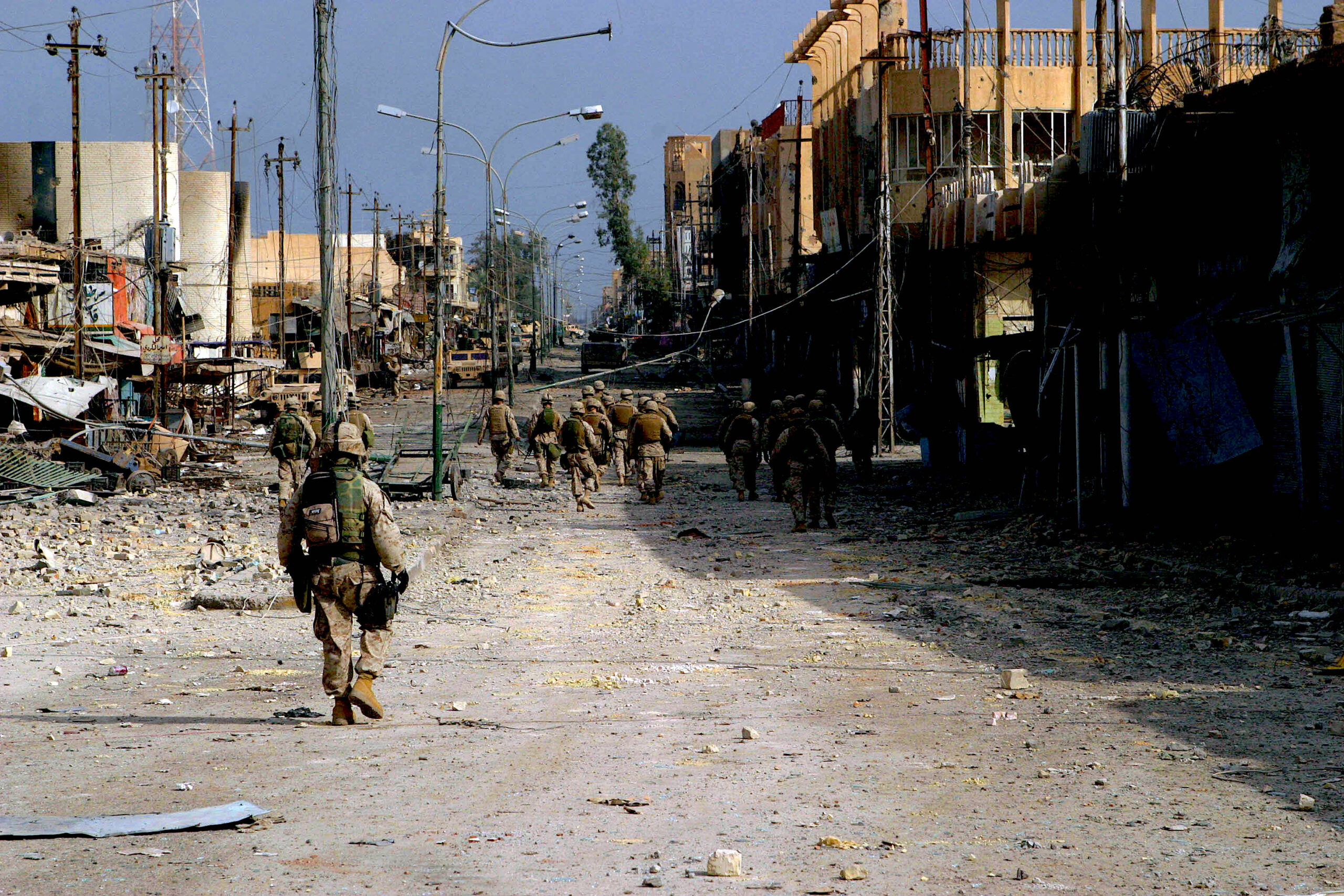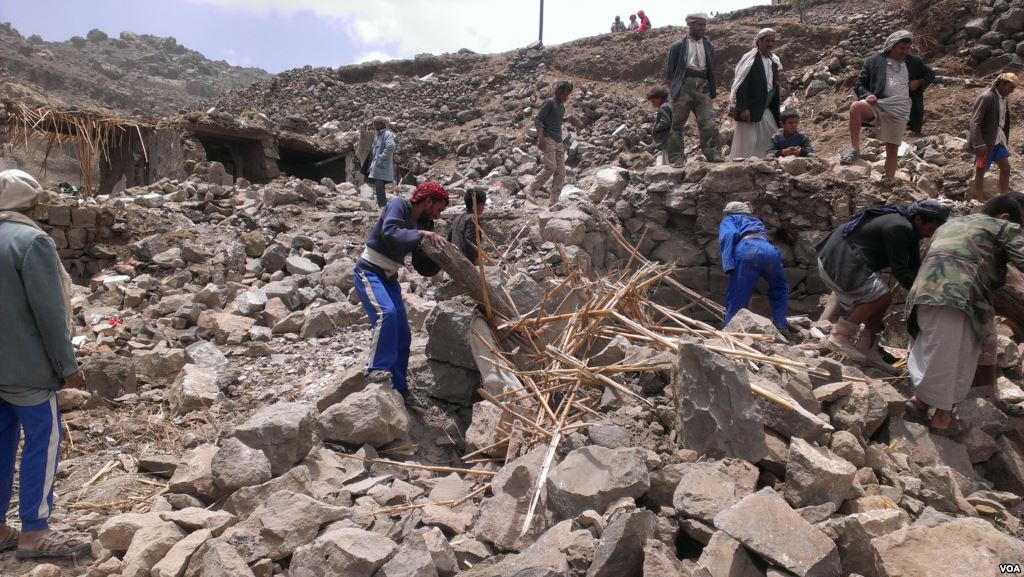
A courtyard of Googleplex, the Mountain View, California, headquarters of Google, 2014. (Runner1928, CC BY-SA 3.0, Wikimedia Commons)
 A congressionally appointed panel, called the National Security Commission on Artificial Intelligence, is recommending that the United States military launch a major program to develop autonomous weapons powered by artificial intelligence (AI) software.
A congressionally appointed panel, called the National Security Commission on Artificial Intelligence, is recommending that the United States military launch a major program to develop autonomous weapons powered by artificial intelligence (AI) software.
The panel, led by Google’s former chief executive, Eric Schmidt, has prepared a report that calls for the expenditure of $20-30 billion to advance the program.
There is a set of things that have to happen in America to maintain leadership globally… #AI is the #technology that drives our economic output… and we need to do whatever it takes… It’s not so much the money as it is getting the forces aligned. – #NSCAI Chairman @EricSchmidt
— National Security Commission on AI (@AiCommission) February 23, 2021
Its vice-chairman, Robert Work, a former deputy secretary of defense, said autonomous weapons are expected to make fewer mistakes than humans do in battle, leading to reduced casualties. “It is a moral imperative to at least pursue this hypothesis,” he said.
The draft report recommends that Washington “adopt AI to change the way we defend America, deter adversaries, use intelligence to make sense of the world, and fight and win wars.” (Work is on the board of directors for Raytheon, and board of advisers for Govini, a big data and analytics firm committed to transforming the business of government through data science.)

Eric Schmidt, at right, in 2013. (Chatham House, CC BY 2.0, Wikimedia Commons)
Categorical moral imperatives from On High is something I missed out on while growing up. The cost of a misspent youth. How I envied our aging Scottish neighbor who regaled me with tales from his childhood of attending Calvinist services in Dunfermline. There, in church every Sunday, he was instilled with the righteous obligation to improve himself by a steely preacher of stern rectitude. I, by contrast to those youthful uplifting spiritual experiences, whiled away the Lord’s Day by lounging in front of the TV watching ballgames.
So, I am thankful for the high-minded admonitions issued by Silicon Valley’s best and brightest that I have a “moral imperative” to support spending some tens of billions on Artificial Intelligence directed weapons that kill only those who deserve it, i.e. Washington’s chosen “Elect.” Now I have the moral cause that I have been missing all these years – its absence being the source of my irresolute vacillation on matters of violent death and destruction.
“I propose… [we] adopt the #AI commission’s recommendations, which are coming out on March 1st.” – #NSCAI Chairman @EricSchmidt
— National Security Commission on AI (@AiCommission) February 23, 2021
Admittedly, some unfortunate habits of thought tenaciously resist being wholly uprooted. The proclivity to test faith-based military doctrines against reality is one of them. Awkward questions keep popping up to impede my progress along the road of Ethical Truth and Redemption. Therefore, I am earnestly beseeching your assistance in laying those doubts to rest. Here they are, in summarized format.

The U.S. military’s “shock and awe” bombing of Baghdad at the start of the Iraq War, as broadcast on CNN.
No. 1 “Shock & Awe” The March 2003 bombing of hundreds of sites across Iraq was intended to cow the Iraqi leadership into surrender as well as to clear the way for the invasion. Large buildings, installations and complexes were destroyed with thousands of casualties. Question: how would AI weapons systems have affected this strategy? Is there a more precise version of “Shock & Awe” which has the same psychological and military impact?
No. 2 Fallujah In the course of the war, American forces levelled most of Fallujah — twice, driving a hundred thousand or so into the desert. Question: given that the enemy were dispersed throughout the city, and camouflaged, what would have been the capability of AI systems to identify appropriate targets through algorithm-driven searches in data banks for retina matches, facial recognition. etc? How might the civilians be alerted by the guys at Fort Meade and at Central Command that there was no match for them and that they safely could stay home watching CNN videos of the assault on their TVs?

Nov. 15, 2004: Street in Fallujah heavily damaged by fighting. (U.S. Marine Corps, James J. Vooris)
No. 3 Mosul & Raqqa In the campaign against ISIS, we razed most of Mosul and Raqqa. The Marines alone fired 20,000-plus artillery shells into Mosul, a densely populated city of well over a million. The Air Force flew 30,000-plus combat missions. The French air force, the Iraqi air force, the National Army, and the Shi’a militia also fired on the city.
With all this firepower, it took several weeks to clear Mosul of ISIS fighters. Civilian casualties and refugees have been too numerous to count. Question: how would AI have enabled us to achieve the same objectives in sanitary fashion in the light of ISIS tactics of evasion that were far more complex than those encountered in Falluja?
(The other alternative for taking an urban area is fighting house-to-house with only limited artillery and air support. That, of course, means higher casualties for combat troops. Razing the city in effect substitutes civilian casualties for military casualties among the attacking force – at a ratio of 10:1 or 20:1?)

An American soldier carries a wounded Iraqi child to a treatment facility in March 2007. (James F. Cline III, Wikimedia Commons)
No. 4 Libya Here the U.S. provided the bulk of the firepower to topple and kill the country’s leader, Muammar Gaddafi. With his grip removed, the country has succumbed to a decade of nearly continuous multi-party strife with death, devastation and mass dislocation in its train. Currently, the political scene is dominated by the power struggle between two warring coalitions.
One, based in Tripoli, was installed by Washington and its allies, and has a nominal status as the internationally recognized government. The other, centered in the eastern city of Benghazi, is led by General Khalifa Haftar who won favor by defeating some of the jihadist militias that have flourished since Gaddafi’s death. The former is backed by Saudi Arabia, the UAE and especially Turkey’s leader Recep Erdogan, who has transferred thousands of his al-Qaeda, ISIS and other militant proxies from Syria.

Aerial view of Tripoli, Libya, in 2011. (MrPanyGoff, Wikimedia Commons)
Tripoli itself is dominated by Islamists. Haftar has the backing of neighboring Egypt, Jordan, Russia and France. Various tribal militia and jihadi movements roam the vast interior of Libya. The United States recently has equivocated in its support while urging the two sides to reach a modus vivendi — with little success. Question: Washington provides arms, directly or indirectly, to ALL of the above-mentioned parties — except the Islamist militias. Would its influence increase and its objectives have a better chance of being realized were those arms deliveries to include AI weapon systems?
No. 5 Yemen: The Saudi-led slaughter and starvation of Houthis has depended crucially on the participation of the American military. Their campaign would have been impossible without U.S. airplanes providing refueling, U.S. officers sitting at Saudi command headquarters to direct targeting and U.S. Intelligence. In addition, we provided the latest in “smart” bombs and missiles. We also helped to enforce the blockade that denied food and medicine to the general population. The Saudi intention has been to coerce the Houthis into submission by causing as much misery as possible. Question: how would extensive employment of AI weapons systems have changed any of this? Would not the critical ‘targets’ be located in Washington, Tampa, and Riyadh which are readily accessible to non-AI assisted weapons?

A destroyed Yemeni village. (Almogdad Mojalli/VOA)
No. 6 The Vietnam War This was a conflict between a country-wide insurrection and a massive counter-insurgency campaign. A major part of the American strategy aimed to deny the Vietcong sanctuary by denuding large areas of vegetation (Agent Orange) and forcing civilians out of broad swathes of territory declared as ‘free-fire’ zones. Would the possession of AI weaponry have altered in a substantial way the conduct of the war, casualty levels and the outcome? How?
No. 7 World War II The carpet bombing of cities became the norm. It culminated in Hiroshima and Nagasaki. Civilian casualties in the earlier fire-bombing of Tokyo were nearly as high. It was apiece with the air raids against Hamburg and Dresden. They all shared the objectives of undermining the enemy’s morale, crippling industrial production — and satisfying the lust for revenge against German air assaults on London, Coventry, Rotterdam and Japanese atrocities. (As the invasion of Iraq was revenge for 9/11). Question: had we access to AI weapons at the time, would this thinking have been any different and actions otherwise?

U.S. aircraft on Tinian Island that took part in the Hiroshima bombing. (Harold Agnew, Wikimedia Commons)
Reflection on these questions leads us to three clear conclusions:
No. 1 Widespread deployment of weapons directed by Artificial Intelligence will have no appreciable change on decisions regarding the use of military force, the conduct of war or on its consequences.
No. 2 Reviewing the history of warfare, or restricting our consideration, to recent wars in the Middle East involving the United States, the fraction of civilian casualties that might be reduced by the use of AI weapons is very low. Those acts of war that produce the vast majority of casualties are not of a kind that allow for the large-scale substitution of AI arms. *
(AI directed weapons will be developed, deployed and used at an accelerating rate – nonetheless. In our post-modern age, any high-tech innovation associated with electronic gadgetry enjoys a presumptive claim to superior utility, value and virtue.)
No. 3 The innovation associated with AI arms, like drones and the volunteer army, could encourage military activism by promising fewer American casualties. The net result, though, could well be more net death and destruction in aggregate.
Several years ago, I attended the Republic Day ceremonies in New Delhi. I had a curbside seat for the parade led by Nehru and his cabinet along the grand Raj Path from the Presidential Palace (Rashtrapati Bhavan) to India Gate. They were followed by other dignitaries, floats, and then an impressive array of turbaned cavalry in magnificent attire. A spectacle worthy of an Imperial Durbar. Indeed, Lutyens had designed it all to honor the Immortal British Raj.
At the very end of the procession, trailing the horsemen at a respectable distance, was a less glamorous squad of khaki-clad “sweepers: who used straw brooms to clean up the manure left behind.
Today’s political world brings back memories of that occasion insofar as we are constantly presented with a huge litter of BS in the aftermath of the latest mega event, and lesser amounts after smaller events. The urgent recommendations in the AI report by the commission falls into the latter category, but lack nothing in pungency.
Overall, there is an imbalance of production and disposal. Shoveling capacity hasn’t kept up. The dilemma for commentators is being placed in the position of New Delhi’s “untouchable” sweepers who are required to do the dirty work of keeping the public space clear of odiferous matter.
Repetition makes the task all the more irksome. It’s as if the 800-strong Light Brigade, commanded by our home-grown Lord Cardigans, passes through daily on march to the Valley of Death. Yes – somebody has to do it, “untouchables” don’t exist, and the best solution would be to stable the “horses.” The chances of the last happening any time in the foreseeable future are nil.
I personally have taken leave. So, instead of a systematic dismantling of the report, I have followed the avoidance strategy of restricting myself to the few remarks and questions presented above.
* The pitchmen for AI weaponry base their promotion on a mistaken conception of warfare. They presume that it is essentially instrumental in nature. It is not. Destruction, looting and brutalizing civilians is an integral part of war – usually.
At the extreme, think of Attila the Hun whose armies slaughtered and pillaged routinely, or Genghis Khan’s Golden Horde who did the same, or Timur whose calling card was a pyramid of skulls at the city gate, or the Nazis. For them, antiseptic warfare would have been anathema – taking all the fun out of it.
The passions of wars inspired by religion or other ideologies also bode ill for non-combatants: e.g. Joshua’s annihilation of Jericho – obedient to orders from his Commander; the Crusades; the 17thCentury’s Thirty Years War; the Islamic State’s recent rampage. Or the scourge of modern nationalism.
Were the Serbs shelling Sarajevo concerned about precision targeting? Would Radovan Karadzic or Slobodan Mladic have welcomed AI weapons as a solution to a moral dilemma that endangered their immortal souls?
In all of these instances, the very notion of “collateral damage” was irrelevant.
Michael Brenner is a professor of international affairs at the University of Pittsburgh. mbren@pitt.edu
The views expressed are solely those of the author and may or may not reflect those of Consortium News.



The technical mind is a beautiful thing—with all of those calculating abilities. As an artist I naturally understand artists, but also recognize those folks with a technical bent as well. I can see them, and appreciate the techies for their skills. But what is interesting is they cannot see me. It seems since I have not the mathematical skills as finely tuned as they, I do not exist. I am merely a simpleton.
The psychology of all of this had fascinated me for some time. Any one I have ever known with a highly technical mind also has a blind side the size of the State of Montana. It is as if those that are endowed with such skills must do so at birth by accepting the loss of other faculties: Color-blind, tone deaf, zero creativity. Lay out a page and simply line things up? Write a paragraph? Choose a color? Draw a design? Write a song? Not.
Microsoft is an excellent case in point. Everything that company has ever produced is ugly–”dorky” describes it better. If they actually hire artists they don’t use them. Their software is designed by and for those with a naive technical mindset (the rest of use are stupid). Their operating systems therefore can be difficult in odd ways. (“intuitive” is a catch word for yet even more pull-down menus)
The photo at the beginning of this article is telling. Googleplex is vomit ugly! The hideous green plastic furniture pushes it all over the top.
The point of my rant is this: We live in a society that honors and promotes those with high math skills, but one must ask the question: In a sane world, would these folks be making command decisions?
Here Michael Brenner has made very wise observations, and asked poignant questions. Questions that have only one reasonable answer.
Artificial Intelligence (AI) is just that. Data collection is not equivalent to wisdom. Funny how this has not yet become apparent, to inhumanity, in its conduct.
Will the application of algorithms (a set of computational directives) to human responses eventually replace all living organisms’ forms of social interaction and become the virtual, substitute process, fatuously deemed equivalent – by those orchestrating the fraud for being perpetrated against the ‘thinking’ species’ hard-won, actually lived, experiential wisdom?
Collated electronic data is not real lived experience. At most, anything computer-generated, in this vein, is mere dystopian, cybernetic concocted theory of human behavior. Although many of us do perform like mindless robots, I seriously hope that this is not the actual intent of the ‘gods’ of ‘mechanistic anthropomorphism’.
Given that ‘mind’ so far as is scientifically known at the present moment in time, is not merely as basic and simplistic as “communication/control theory” would have it; is a simulated manufactured autonomic control system an adequate sort of prosthesis. The very idea is preposterous!
By no stretch of the scientific imagination, as yet, has ‘mind’ been definitively determined to be merely a ‘function’ of organic chemical interchanges between “the neural brain structures and mechano-electrical communication systems”.
If the human mind is able to be reduced – due to the present dominance and marketing power of the Artificial Intelligence (AI) manufacturing community, to purely a function of robotics, then we the people have been relegated to mere isolated (alienated) widgets of our own lives, adroitly separated from our natural innate humanity, by the offspring of this machine breed.
Is it not an unstated goal of totalitarian corporatism to reduce, as threat, any dissenting voices to their devices of ‘command and control’, which needs to be curtailed, as in the restriction of ‘free speech’ to only those credentialed to speak on behalf of global corporatist man?
As things are degenerating right now, socially, politically and economically (culturally) we are well on the way to a desensitized, perceptively distorted, objective reality – seen through our inner mental filters shaped by historic mass conditioning.
What are algorithms other than weighted compilations of preprogrammed projective assumptions about repetitive human behaviors. These formulae say absolutely nothing about the holistic organization and function of mind. This is nothing more than attempting to improve on stereotyping: attempting to assess the content of individual human beings, without taking into account the full extent and infinity of heart, mind and spirit.
Isn’t the practice of stereotyping “others” behavioral reactions akin to assuming an outcome? Attempting to enforce this by algorithmic application is Frankenstein revisited.
Stereotyping of individuals is frowned on by society’s ethical censors – so-called human rights advocates, yet how is it then that prediction by applied algorithm is not likewise frowned on and overwhelmingly vetoed? Could it possibly have anything to do with the fact that making money through the deceptive employment of patented/trademarked, monopolist, exploitative processes, are still sanctioned as legitimate capitalist methods of societally uplifting productive endeavor?
Memories of our phony reasons to invade Iraq, et al, will go with me to the grave. Now the idea of letting those Dept. of Defense IDIOTS and the Military Industrial Complex (MIC) WHO OWN THE UNITED STATES OF AMERICA… just the idea of putting a blame game in place for them such as AI, … not counting the billions of our taxes–not MIC’s taxes, our taxes, we will spend on it…. makes me… just sad.
Well said, war is not only Hell, it’s the total disruption of anything human kind could call decent!